Edmund Dulac (1882-1953) published in the first decades of the twentieth century, at a time now recognised as a golden age of children’s book illustration. His use of intense colour combinations for their decorative effect over his carefully drawn pencil foundations, inspired at first by Persian and Indian miniature painting, has made a lasting impact on children’s book illustration.
The creation of Gift Books
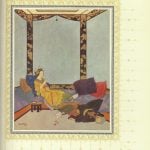
The Lady Bedr-el-Budur and the Wicked Magician, from Sindbad the sailor and other stories from the Arabian nights, plate opp. p. 136.
Reproduction of illustrators’ work from this period employed a technique of colour photography that resulted in a near exact copy of the original.
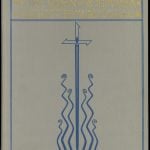
Cover, The Dreamer of Dreams
This half-tone technique was developed by Carl Hentschel and involved three negatives taken through different coloured filters from which blocks could print yellow, red and blue half tone elements of a picture.
The technique required careful placement of the blocks and heavy glazed paper to take the inks.
The resultant Gift Books, as they were known in the trade, were beautifully made with decorated end papers, the colour plates printed on glossy art paper were tipped in to a courser grade backing paper, and separated from the text by tissue paper.
The new half-tone process enabled artists to play with technical tricks not previously possible with wood block printing. For example, Arthur Rackham tinted his drawings with a minimum of colour to produce subtle harmonies.
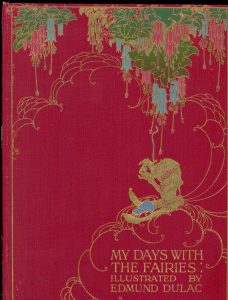
Cover, My Days with the Fairies
In contrast, Dulac remained true to the watercolour medium and made fuller use of colour having worked from carefully drawn pencil foundation subsequently hidden by the watercolours.
Early life
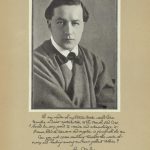
Portrait, from Edmund Dulac’s Picture-Book for the Red Cross
Edmund made his first painting as a child of eight years – a landscape with a cottage on the lid of a wooden box. By age twelve his painting showed sensitive observations and a sound technical ability. By 16 he showed an interest in studying people in their everyday activities, reflecting a flair for character and movement.
Despite these early signs of creativity, his parents suggested Dulac study law, while simultaneously attending classes at the Ecole des Beaux Arts. When he won the first of numerous prizes for his artwork at the Ecole, he left his legal studies. In 1903, after completing his three year course at the Ecole, he won a scholarship to the Academie Julien, a prestigious independent art school in Paris.
A young Kay Nielsen enrolled there a few years after Dulac left. But Edmund was unhappy there with many of the tasks set, such as drawing from plaster casts or copying paintings of immense battle scenes.
Born in Toulouse France Dulac moved to London in 1904 and became a naturalised citizen of Britain in 1912. There he joined the London Sketch Club, an organisation founded in 1898 for professional illustrators to meet and discuss their work. Members held weekly drawing sessions and informal showings of work done in the intervening time. There Dulac met the foremost book and magazine illustrators of the time, including W. Heath Robinson and Willy Pogany.
Publication
These contacts led to an association with Leicester Galleries where he submitted works to their annual exhibitions; and with Hodder & Stoughton, who acquired the publishing rights for many of Dulac’s artworks for their illustrated gift book series. Under this arrangement Hodder & Stoughton produced Sindbad the Sailor and Other Stories from the Arabian Nights, The Tempest and The Rubaiyat of Omar Khayyam which together amounted to the reporduction of 110 colour images of Dulac’s artwork.

Episode of the Whale, from Sindbad the Sailor and Other Stories from the Arabian Nights, plate opp. p. 16
Dulac illustrated the amazing adventures of Sindbad over the protagonist’s seven voyages undertaken by Sindbad to rebuild himself after squandering his inheritance. During his first voyage Sindbad and his companions come upon an island like no other, that seems like part of Paradise had established itself in the sea. They cast anchor, land and cook food only to be disturbed by the master of the ship who calls out for everyone to save themselves. The island is in fact a whale preparing to submerge. The main illustration for the Episode of the Whale is shown here.
The Tempest was Dulac’s second major gift book issued in both a limited edition and standard edition. Shakespeare’s comedy opens in the midst of a storm with the King of Naples ship desperately trying to stay afloat. Prospero watches on land having used his magic to call up the storm as revenge for being cast him adrift. Twelve years earlier Prospero and his daughter Miranda were put to sea in a raft and miraculously landed safely on this island.
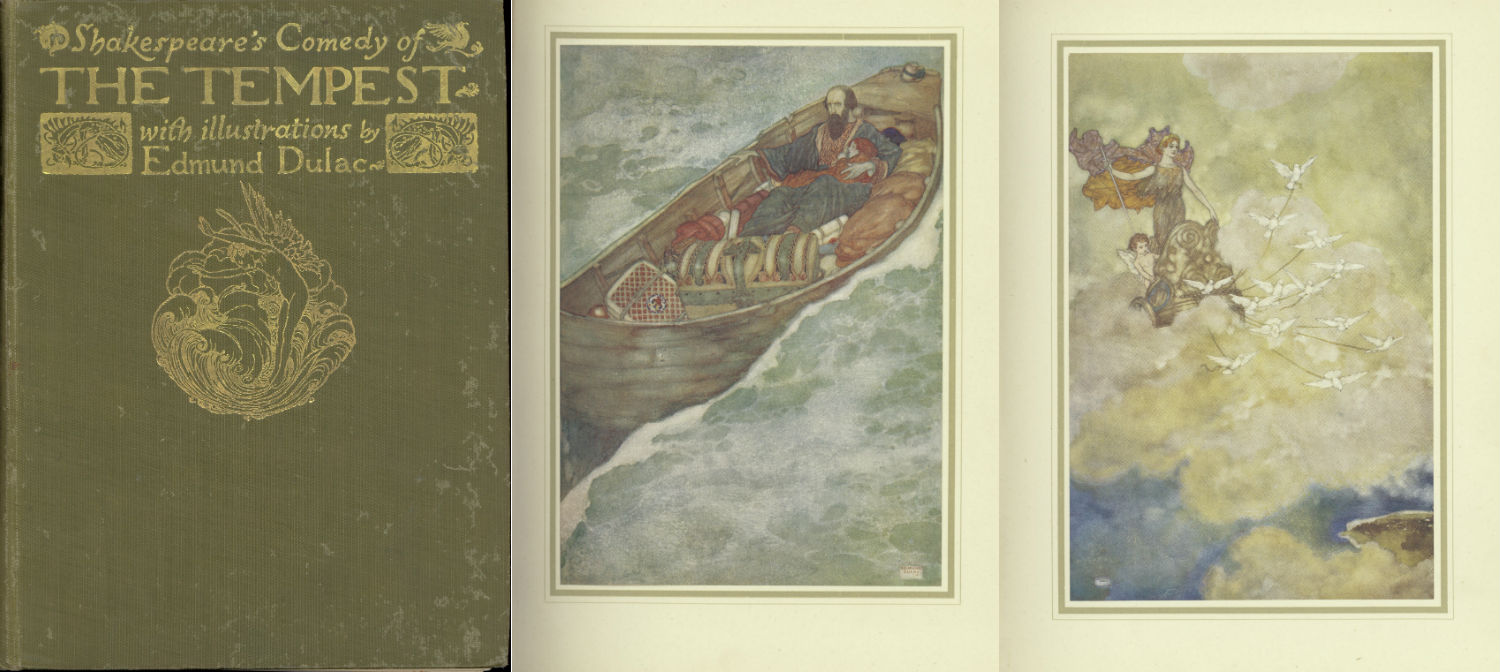
From left to right: cover, Venus and her son flying through the clouds towards Paphos (plate opp. p. 70), Prospero and three year old Miranda abandoned on the bark (plate opp. p. 10), The Tempest.
Both illustrations shown here show combinations of greens and blues in both land and sea imagery. Dulac designed the cover, title page and an invitation card to the opening of the exhibition of his pictures for The Tempest at the Leicester Galleries on November 14, 1908.
The Rubaiyat was first published in 1909 in a limited edition and a trade edition in London and New York. This is the 1919 American edition containing 20 plates by Edmund Dulac. Edward FitzGerald, English poet and writer, loosely based his ‘translation’ on Omar Khayyám’s quatrains. The Guardian blog commemorating the birth of Edward FitzGerald suggests the 101 verse assembled by FitzGerald is the product of a ruthless editorial job from the original, yet that English poetry would be poorer without it. The blog explains that Khayyám, an agnostic 11th and 12 century mathematician and astronomer, and his mediator, a 19th century English sceptic who believed that science reveals a better epic than the Iliad, seemed to have been a marriage of true minds in The Rubaiyat.
Dulac’s illustration for the first quatrain is considered to be one of his finest works. This image of daybreak as the Sun strikes the Sultan’s Turret depicts Omar’s view of the city as seen from a high terrace. Trees emerge from the neutral colours of night to receive flashes of orange, purple and deep blue-greens of a hot summer’s day. The aerial view incorporates the first light on domes as the Sun God rising over the distant mountains, turns his glance.
Perhaps best known for his illustrations in his fairy books and fantasies, Edmund Dulac’s Fairy Book contains tales written and illustrated by Dulac which are drawn from the folklore tradition of countries from England, Ireland, Russia, Europe, Serbia and Japan.
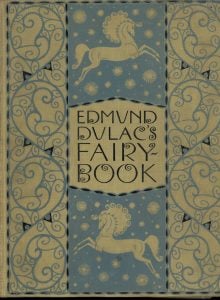
Cover, Edmund Dulac’s Fairy Book
The Buried Moon is an English fairy tale about the demise of a female figure of the moon. Wrapped head to foot in a dark cloak and hood, the Moon descends from the sky to a treacherous bog during the dark end of the month. There she trips near the jet-dark bog and clings to an overhanging branch. Tendrils from the branch wrap around her wrists like manacles.
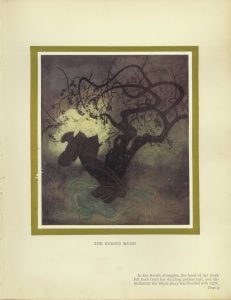
The Buried Moon, from Edmund Dulac’s Fairy Book, plate opp. p. 8
A man who has lost his way comes to her aid but to help her his own death would be imminent. In her struggles the Moon’s hood falls back and the whole scene is flooded with light. Realising how close to death he is, the wayfarer escapes but the exhausted Moon’s head sinks to her chest, then her hood falls over the dazzling light and the evil bog creatures consume her.
In contrast to the previous dire story, in My days with the fairies Dulac displays a humorous and whimsical style. These images are from the new and enlarged edition published September 1913. His subjects are painted at close range.

Title page and The Big Spider’s Diamonds (unnumbered plate), My Days with the Fairies
In The Big Spider’s Diamonds story Sun Fairies play a trick on a vain spider. The Big Spider spins a beautiful web between two blades of grass in an intricate and difficult pattern. Overnight the Dew Fairies place their diamonds on all the webs in the garden but the Big Spider was so busy admiring the effect on his web that he didn’t notice the others.
The Big Spider busies himself inviting all the flies in the garden to admire his beautiful web, allowing the Sun Fairies to steal his diamonds. But the Rain Fairies throw more diamonds down on the spider and his web causing both to fall to the ground, where the Dew Fairies quickly gather their diamonds for another night.
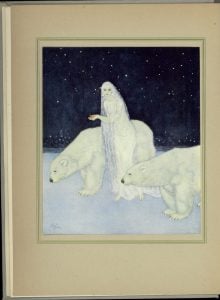
Frontispiece, from Dreamer of Dreams
The Dreamer of Dreams was Hodder &Stoughton’s featured “new art gift book” for 1915. The frontispiece of the white princess accompanied by two white bears was widely praised in contemporary review magazines. This marked the development of Dulac’s signature depiction of a star filled night sky containing a woman walking in the foreground with huge animals.
The Dreamer of Dreams is the story of an acclaimed young artist named Eric Gundian who sees in a dream two eyes that make an enormous impact on him. He sets out on a quest to find these eyes so that he could complete his art work for King Wanda of the Northern Kingdom. At the end of his journey an old woman leads Eric to a young girl playing a violin who has the eyes he has been searching for.

King Wanda with his Daughter Oona, from Dreamer of Dreams, plate opp. p. 172.
Much later King Wanda is seen sitting with his daughter Oona, enjoying the first warmth of spring when a ragged traveller asks for his audience. The traveller is Eric’s spirit who has returned to finish the painting for the King with the eyes of the beautiful violin player he had found.
Following the outbreak of WWI, Hodder and Stoughton asked Dulac to prepare a compilation of his own favourite artwork. Published at the intentionally low price of three shillings to guarantee huge sales, Edmund Dulac’s Picture-book of the French Red Cross made an outright profit of 1000 pounds for that organisation, which went to the ensuing war effort.
This book contains 20 colour plates, mainly taken from Dulac’s previous book and magazine illustrations, together with a splendid new watercolour for ‘The story of the Bird Feng’. Every drawing produced by Dulac in 1915 was done without personal salary, all profits going to war charities.
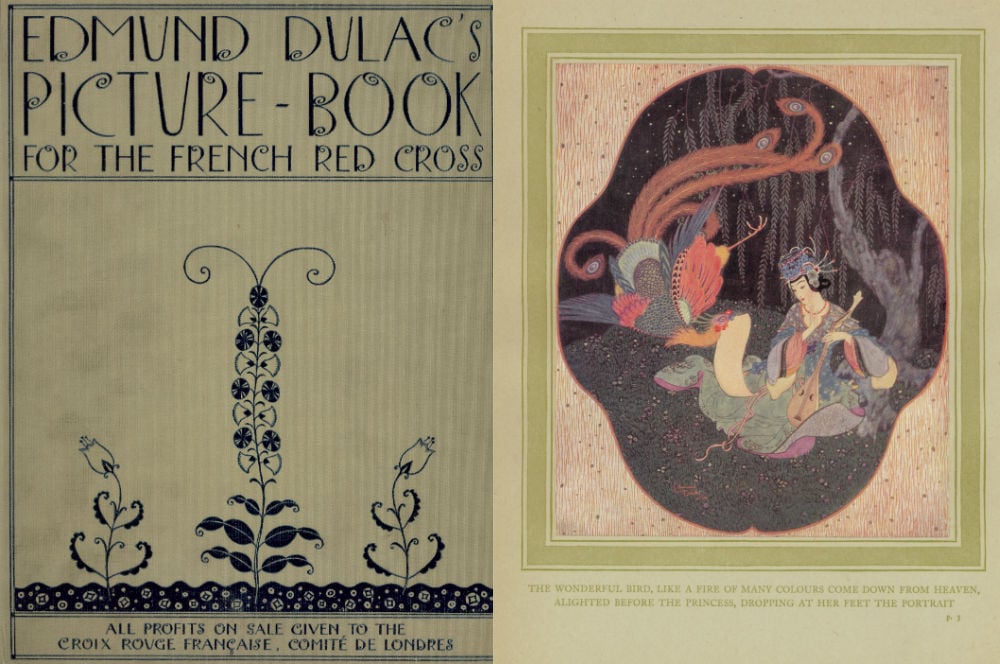
Cover and The Bird Feng (plate opp. p. 1) from Edmund Dulac’s Picture Book for the French Red Cross
This is the first English edition of Lyrics pathetic and humorous from A to Z published in November 1908. These images depart from those Dulac creates for his fairy tales and reflect his breadth of individual style. It wasn’t until 1915 that he returned to humorous art when he began drawing black and white caricatures of well-known personalities.

The Letter H, from Lyrics Pathetic and Humorous from A to Z
Each design has a thick black line border around the image and again around the verse placed at the bottom of the page. The parchment endpapers depict a minstrel strumming behind 4 burning candles.
The rear endpaper shows the minstrel walking towards the end of the book with all 4 candles extinguished after burning down to their wick.
Edmund Dulac and his wife cruised the Mediterranean in 1913 and this trip inspired Edmund to work on a set of pictures related to Greek mythology. He began this series in 1914 and completed it in 1918 for Tanglewood Tales.
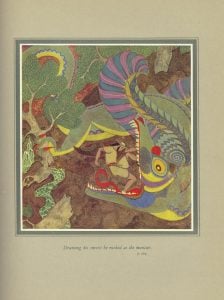
Drawing his Sword He Rushed at the Monster, from Tanglewood Tales, plate opp. p. 88.
Contemporary reviews commended the illustrations in this book for being one of Dulac’s most harmonious sets, painted uniformly in a style derived from the ancient classical world. Dulac drew upon these same inspirations for designs for six charity fund tokens.
Tanglewood Tales show Dulac’s fascination with the centaur theme. The cover and end papers of Tanglewood Tales depict male centaurs in silhouette.
Tanglewood Tales is a set of six stories written by American author Nathaniel Hawthorne (1804-1864), who rewrote classical Greek myths for child readers.
The Kingdom of the Pearl is a non-fiction treatise on the formation of pearls. First published in French as Au Royaume de la Perle in 1919 without decorations by the author Claudius Denis, a limited edition of 1500 copies of the French version followed in October 1920 illustrated by Edmund Dulac.
The English version shown here was published in December the same year and included 10 of Dulac’s coloured plates.
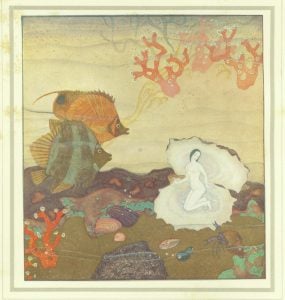
The Birth of the Pearl, frontispiece from The Kingdom of the Pearl.
These pictures display the development of Dulac’s Persian miniature style first seen in Sindbad the Sailor, employed in some illustrations in his Fairy Book, and developed fully in Tanglewood Tales.
Here his illustrations bring a mature yet fanciful touch to the otherwise stark non-fiction treatise on pearls. Dulac cleverly imparts personalities to various species of marine life worked into his designs.
Additional information about Dulac’s influence on fairytale illustration can be found in the references below.
Dulac’s children’s book can be viewed in the Library’s Heritage Collection reading Room when pre-ordered.
Future blogs will examine the works of other Golden Age illustrators.
References
- Dewan, Pauline, ‘Perennially popular’ in Children & Libraries, vol. 14 (2) Summer 2016 pp. 27-31. [Discusses how fairy tales appeal and enable child readers]
- Dobson, Eleanor, ‘Sleeping beauties: Mummies and the fairy-tale genre at the fin de siecle’ in Journal of International Women’s Studies, supplement New Writings in Feminist Studies, vol. 18 (3), Feb 2017, pp. 19-34. [Examination of the relationship between fiction about mummies and mummification and the fairy tale genre at the end of the 19th century]
- Edmund Dulac, in Oxford Dictionary of National Biography, online
- Edmund Dulac Fairy Tale Illustrations, in Art Passions online
- Edmund Dulac, his book illustrations: a bibliography, by Ann Conolly Hughey, 1995
- Kite, Lorien, ‘Stranger things’ in Financial Times, 20 Aug 2016, p. 14. [Reflections on Shaun Tan’s interpretation of a selection of Grimm’s fairy tales for Singing Bones]
- Larkin, David (ed), Dulac, 1975,
- Poem of the Week: The Rubaiyat of Omar Khayyam, Dec 29 2008, in The Guardian
- White, Colin, Edmund Dulac, 1976.
- To pursue more research on the Library’s Children’s Literature Research Collection go to the Children’s Literature Research Guide

